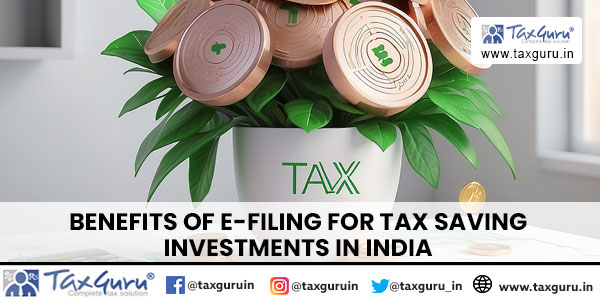#AD
Benefits of E-Filing for Tax Saving Investments: ELSS, PPF, and More
In India, tax saving investments are crucial for individuals to minimize their tax liability and achieve long-term financial goals. The Indian government offers various tax-saving schemes, such as Equity Linked Savings Scheme (ELSS), Public Provident Fund (PPF), and more. E-filing, which involves submitting tax returns electronically, has become the preferred method for many taxpayers due to its numerous benefits. This article explores the advantages of e-filing for tax saving investments in India.
Introduction to Tax Saving Investments
Tax saving investments are designed to help individuals reduce their tax liability by providing tax benefits. These investments are categorized into different schemes, each with its unique features and benefits. Some of the most popular tax saving investments in India include:
- Equity Linked Savings Scheme (ELSS): ELSS is a type of mutual fund that offers tax benefits under Section 80C of the Income Tax Act. It allows individuals to invest up to ₹1.5 lakhs per annum and claim a deduction from their taxable income.
- Public Provident Fund (PPF): PPF is a long-term savings scheme that offers tax benefits under Section 80C. It allows individuals to invest up to ₹1.5 lakhs per annum and claim a deduction from their taxable income.
- National Savings Certificate (NSC): NSC is a fixed-income instrument that offers tax benefits under Section 80C. It allows individuals to invest up to ₹1.5 lakhs per annum and claim a deduction from their taxable income.
- Fixed Deposit (FD): FD is a type of savings account that offers tax benefits under Section 80C. It allows individuals to invest up to ₹1.5 lakhs per annum and claim a deduction from their taxable income.

Benefits of E-Filing for Tax Saving Investments
E-filing has become the preferred method for submitting tax returns in India due to its numerous benefits. Some of the key advantages of e-filing for tax saving investments include:
- Convenience: E-filing allows individuals to submit their tax returns from the comfort of their own homes. It eliminates the need to physically visit a tax office, reducing the time and effort required for tax compliance.
- Speed: E-filing is faster than traditional filing methods. Taxpayers can submit their returns within minutes, ensuring timely compliance with tax laws.
- Accuracy: E-filing reduces the risk of errors and inaccuracies in tax returns. It ensures that all required information is accurately filled and submitted.
- Security: E-filing is a secure method of submitting tax returns. It uses advanced encryption techniques to protect taxpayer data and prevent unauthorized access.
- Tracking: E-filing allows taxpayers to track the status of their returns in real-time. This ensures that they are aware of any issues or discrepancies that may arise during the processing of their returns.
- Verification: E-filing requires taxpayers to verify their returns electronically. This ensures that the returns are accurate and complete before they are processed.
How to E-File Tax Returns for Tax Saving Investments
E-filing tax returns for tax saving investments involves several steps:
1. Gather Required Documents: Taxpayers need to gather all required documents, including investment certificates, bank statements, and other relevant documents.
2. Choose a Filing Method: Taxpayers can choose between two filing methods: ITR-1 (SAHAJ) for individuals with income from salary, interest, and other sources, and ITR-2 for individuals with income from business or profession.
3. Fill the Return: Taxpayers need to fill the return accurately, ensuring that all required information is included.
4. Upload Documents: Taxpayers need to upload all required documents electronically.
5. Verify the Return: Taxpayers need to verify their return electronically to ensure its accuracy and completeness.
6. Submit the Return: Taxpayers need to submit their return electronically.
Conclusion
E-filing is a convenient, accurate, and secure method of submitting tax returns for tax saving investments in India. It offers numerous benefits, including convenience, speed, accuracy, security, tracking, and verification. By following the steps outlined above, taxpayers can ensure timely and accurate compliance with tax laws. For more information on e-filing and tax saving investments, taxpayers can visit the official website of the Income Tax Department of India.




